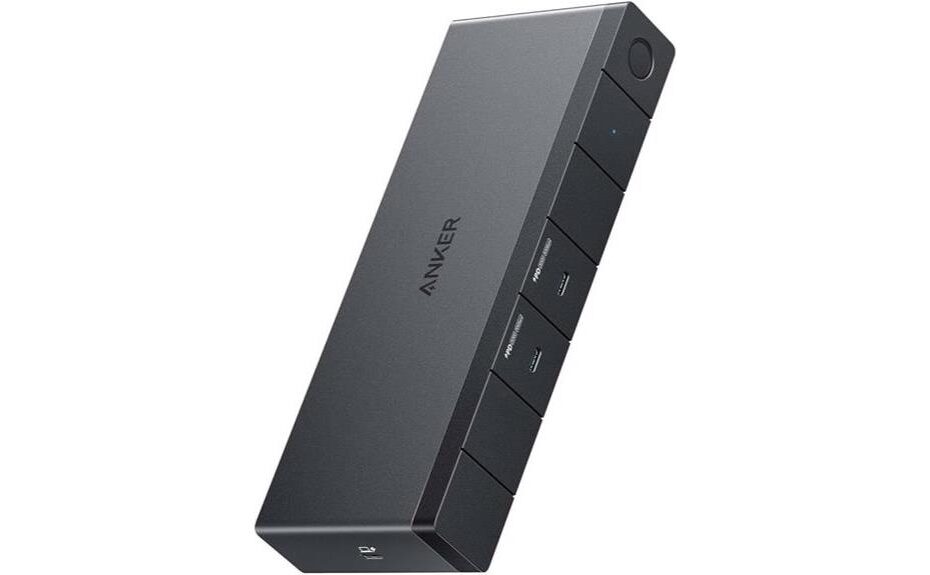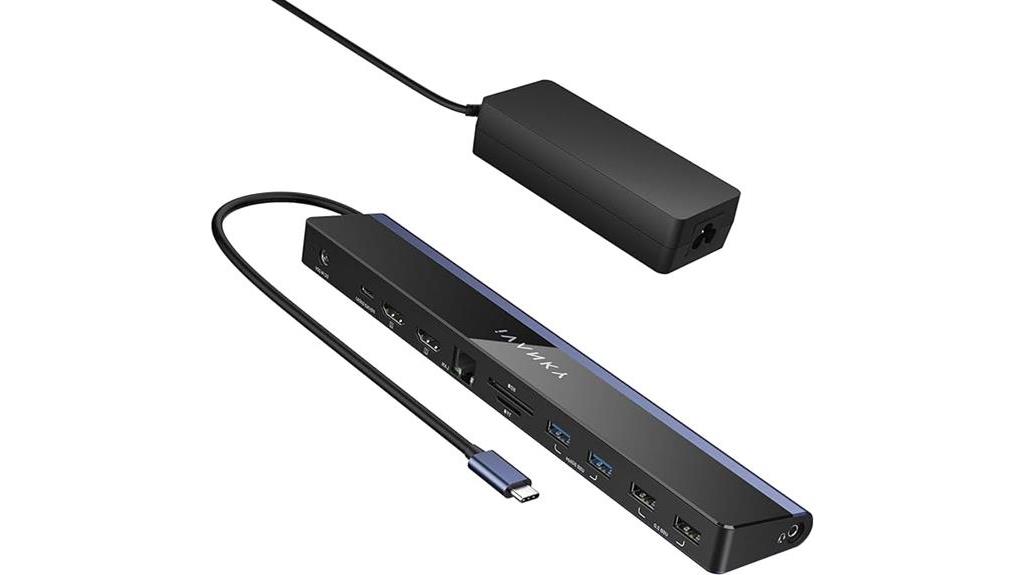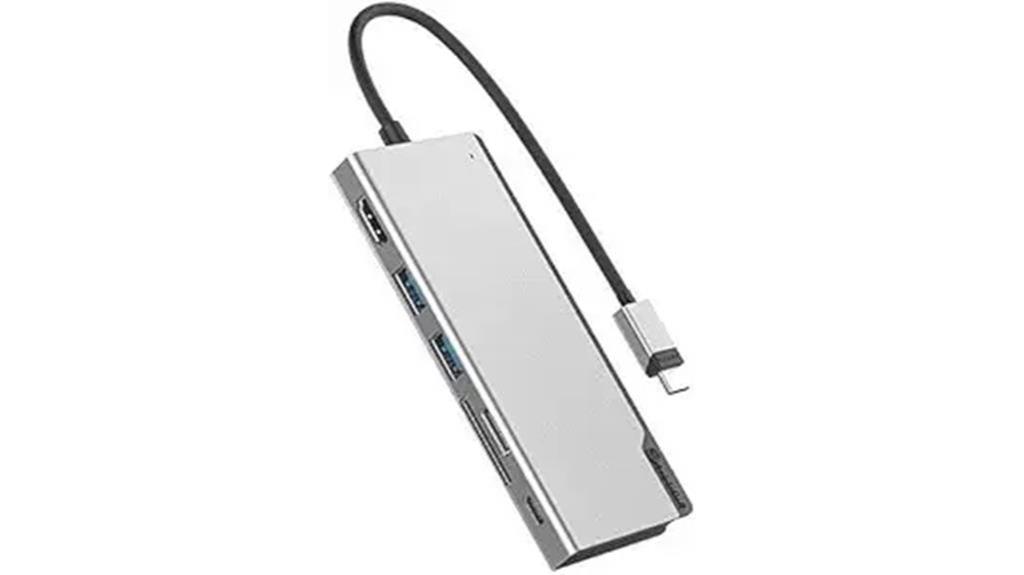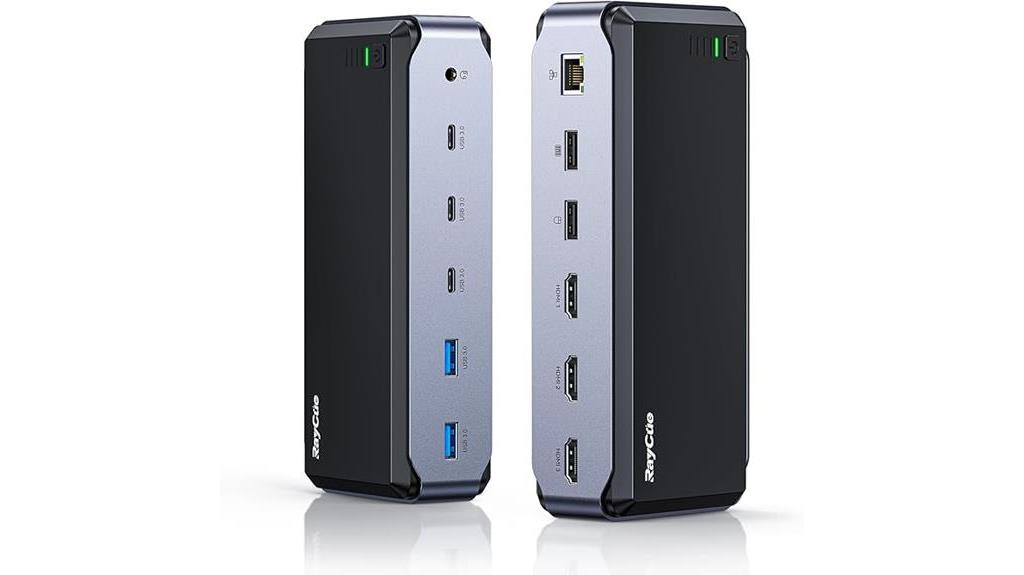



I've looked into the Anker 568 USB-C Docking Station, and it offers an 11-in-1 design with excellent display support, including single 8K and triple 4K options. However, I've noticed inconsistent charging capabilities and Ethernet connectivity issues that can hinder performance, particularly for gamers and heavy users. Despite its solid build and high-speed data transfer potential, the performance flaws can lead to frustration. If you're managing multiple devices and need versatility, it might fit your needs, but be mindful of the drawbacks. There's more to explore about optimizing its performance for various tasks.
Key Takeaways
- The Anker 568 USB-C Docking Station features an 11-in-1 design with multiple connectivity options, but users report inconsistent performance.
- It supports single 8K and triple 4K displays, although monitor recognition issues may arise.
- Users experience connectivity problems, particularly with Ethernet, impacting reliable internet access during tasks.
- The docking station offers high-speed data transfer up to 40Gbps, but power delivery often falls short of the advertised 100W.
- Customer feedback is mixed, highlighting the attractive design and port variety but raising concerns about charging and connectivity reliability.
The Anker 568 USB-C Docking Station presents an impressive array of features with its 11-in-1 design, but I'm keen to explore its performance and real-world usability. While the dock offers a robust set of ports, I've noticed certain design flaws that hinder its effectiveness. For instance, its claimed 100W charging capability isn't consistently validated—some laptops only register 60W. This issue persists despite several firmware updates, which haven't resolved the power delivery limitations for many users. In addition, connectivity problems arise, particularly with Ethernet and monitor displays, raising concerns about its overall reliability. I find it essential to assess these shortcomings before fully embracing the dock's potential in my daily workflow.
Features and Benefits
The Anker 568 USB-C Docking Station offers impressive capabilities, including support for a single 8K display and up to three 4K displays, which I find particularly beneficial for multitasking. However, I've noticed some challenges with Ethernet connectivity and device responsiveness after sleep mode, which can hinder the overall user experience. Understanding these features and their associated benefits is essential for evaluating the dock's performance in real-world scenarios.
Supports Single 8K Display
Supporting a single 8K display, the Anker 568 USB-C Docking Station elevates visual experiences to new heights. With ultra high definition capabilities, it allows me to fully immerse myself in 8K gaming, showcasing vibrant colors and incredible detail that transform my gameplay. The HDMI 2.0 port guarantees seamless compatibility with 8K monitors, making setup straightforward and efficient. This feature is particularly beneficial for gamers and content creators who demand top-tier visuals. However, it's crucial to note that while the dock supports 8K resolution, my experiences with performance can vary depending on the specific graphics card and system configuration. Overall, the ability to connect to an 8K display certainly enhances the Anker 568's appeal for those seeking cutting-edge visuals.
Supports Triple 4K Displays
While the Anker 568 USB-C Docking Station impresses with its capability to support an 8K display, it also excels in handling triple 4K displays. This feature allows me to create a robust triple display setup, enhancing my productivity and multitasking abilities. With the ability to connect three 4K monitors simultaneously, I can efficiently manage multiple applications and tasks without sacrificing resolution or clarity. The docking station's dual DisplayPorts and HDMI output make it easy to configure a multi monitor configuration tailored to my needs. However, while the potential is substantial, I've encountered occasional challenges with monitor recognition and resolution settings, which are critical for maximizing the benefits of a triple display setup. Overall, it's a powerful tool for any serious user.
Supports Ethernet Connectivity Issues
Many users appreciate the Ethernet connectivity feature of the Anker 568 USB-C Docking Station for its potential to deliver stable internet access. However, my experience has shown that the ethernet performance can be inconsistent. I've encountered issues like disconnections and reduced speeds, which can be frustrating, especially during important tasks. While the promise of enhanced connectivity solutions is appealing, the reality often falls short. Some users have reported that performance drops occur during gaming or when handling graphics-intensive applications while docked. This inconsistency can undermine the benefits of having a dedicated Ethernet port. Overall, while the docking station excels in many areas, its ethernet connectivity issues are a notable drawback that prospective users should consider.
Device Responsiveness After Sleep
After waking my laptop from sleep, I've noticed that device responsiveness can be a significant issue when using the Anker 568 USB-C Docking Station. Specifically, when my laptop enters sleep mode, it sometimes struggles to reconnect to peripherals, resulting in delays and hiccups in device performance. This lag can be frustrating, especially during critical tasks that require immediate access to external monitors or USB devices. While the dock offers impressive connectivity options, the responsiveness after sleep mode isn't always reliable. I've found that occasionally unplugging and replugging the dock helps, but it's not an ideal solution. Overall, while the Anker 568 is a powerful docking station, its responsiveness post-sleep could use improvement for a smoother user experience.
Product Quality
When evaluating the product quality of the Anker 568 USB-C Docking Station, it is essential to take into account both its robust design and the reported performance issues. The docking station boasts a solid build that feels durable, but user feedback reveals significant design flaws, particularly in power delivery and connectivity. I've noticed complaints about inconsistent charging capabilities that fail to meet the advertised 100W, and many users express frustration over connectivity problems, especially with Ethernet and display outputs. While the variety of ports is impressive, these performance issues detract from the overall quality. Despite the positive aspects, such as the sleek design, it's clear that Anker needs to address these concerns to improve user satisfaction and product reliability.
What It's Used For
The Anker 568 USB-C Docking Station serves multiple purposes that enhance productivity. I use it for creating a multi-monitor setup, which greatly improves my workflow, while its high-speed data transfer capabilities streamline file management. Additionally, the versatile charging options make it a practical solution for keeping my devices powered throughout the day.
Multi-Monitor Setup
For those who rely on multitasking, a multi-monitor setup can greatly enhance productivity and streamline workflows. I've found that with the Anker 568 USB-C Docking Station, setting up multiple displays is straightforward. This functionality allows me to expand my workspace and manage several applications simultaneously, which boosts my multi-monitor productivity. I can easily drag and drop files between screens, keeping everything organized and in view without constant switching. The ability to connect up to three 4K monitors creates a seamless workspace, perfect for design tasks and extensive data analysis. However, I've noticed that achieving ideal resolutions can be tricky, and some adjustments may be necessary to fully enjoy the benefits of this docking station in a multi-monitor environment.
High-Speed Data Transfer
High-speed data transfer is essential for anyone dealing with large files or extensive data sets, and the Anker 568 USB-C Docking Station excels in this area. With impressive transfer speeds of up to 40Gbps, it effectively minimizes data bottlenecks that can hinder productivity. I often transfer large video files and extensive project data, and this dock effortlessly handles those demands. The multiple USB ports, including USB-C and USB-A, allow for simultaneous connections without sacrificing speed. This means I can quickly back up or share files without waiting around. Overall, the Anker 568 guarantees that my workflow remains uninterrupted, making it an indispensable tool for anyone who prioritizes high-speed data transfer in their daily tasks.
Versatile Charging Options
With the Anker 568 USB-C Docking Station, versatile charging options truly enhance its functionality. I appreciate the charging compatibility it offers, supporting up to 100W of power delivery for laptops. However, I've noticed that this maximum isn't consistently achieved; some devices only register around 60W. This discrepancy can be a dealbreaker for users with high-end laptops that demand full power. Despite the 180W power adapter included, I've encountered challenges when trying to charge while simultaneously using multiple peripherals. Overall, while it provides decent charging options, the limitations in power delivery can hinder its performance. Understanding these nuances is essential for maximizing the dock's potential in various setups.
Product Specifications
The Anker 568 USB-C Docking Station packs impressive specifications into a compact design, making it a robust solution for users seeking versatile connectivity options. Its design aesthetics and build quality reflect a thoughtful engineering approach, ensuring durability and functionality.
Here's a quick overview of the product specifications:
| Feature | Details |
|---|---|
| Ports | 2 USB-C, 4 USB-A, Ethernet, HDMI, 2 DP |
| Data Transfer | Up to 40Gbps |
| Charging Capability | Up to 100W for laptops |
| Dimensions | 8.27 x 3.15 x 1.22 inches; Weight: 1.1 lbs |
With support for single 8K or triple 4K displays, this docking station truly excels in versatility. Overall, the Anker 568 delivers solid performance backed by impressive specifications.
Who Needs This
Professionals who often juggle multiple devices and require seamless connectivity will find the Anker 568 USB-C Docking Station particularly beneficial. If you're working from a home office, this dock can streamline your setup by connecting various peripherals through a single USB-C port. It's especially useful for those who need to switch between a laptop and other devices frequently. Additionally, gamers will appreciate its capability to support multiple monitors, enhancing their gaming setup for an immersive experience. However, if you're using high-end laptops that demand consistent high-wattage charging, be aware of potential limitations. Overall, this docking station caters to anyone looking to enhance their workspace efficiency, whether for professional tasks or gaming.
Pros
Highlighting the Anker 568 USB-C Docking Station's strengths reveals several advantages that cater to a range of users. First, its sleek design aesthetics make it an attractive addition to any workspace, blending seamlessly with modern setups. Second, the user interface is straightforward, allowing for easy connectivity without any steep learning curve. Third, the extensive port selection, including multiple USB-A and USB-C options, provides flexibility for various devices. Finally, the ability to support high-resolution displays, including single 8K or triple 4K setups, enhances productivity for those in creative fields.
- Attractive design aesthetics
- Intuitive user interface
- Versatile port options
- High-resolution display support
Cons
While the Anker 568 USB-C Docking Station offers numerous advantages, several notable drawbacks can hinder its overall performance. I've noticed a few notable issues that potential buyers should consider:
- Inconsistent Power Delivery: The claimed 100W charging capability often falls short, with some laptops detecting only 60W.
- Connectivity Issues: Users frequently report problems with Ethernet connections, including disconnections and reduced performance.
- Display Performance: Some monitors fail to display at the desired resolutions, leading to frustration during use.
- Gaming Performance Drops: I've experienced performance lags in gaming and graphic-intensive tasks when docked.
These factors can markedly impact the user experience, making it essential to weigh them against the docking station's benefits before purchasing.
What Customers Are Saying
Many users have shared their experiences with the Anker 568 USB-C Docking Station, revealing a mixed bag of sentiments. Customer experiences highlight both strengths and weaknesses. While many appreciate the design and the variety of USB ports, user reviews often point to significant issues with power delivery, particularly for high-end laptops. Some users report that their devices only receive 60W instead of the promised 100W. Additionally, connectivity problems, especially with Ethernet and display resolutions, frustrate many. On the brighter side, some users have found workarounds for audio output issues. Overall, the feedback showcases a blend of satisfaction with functionality and disappointment with reliability, leaving potential buyers to weigh these factors carefully.
Overall Value
The Anker 568 USB-C Docking Station offers a compelling mix of features that make it an attractive option for users seeking versatility in connectivity. In my value assessment, it stands out with its 11-in-1 functionality, including support for multiple displays and high-speed data transfer. However, when I conducted a cost comparison with similar products, I found some limitations, particularly regarding power delivery and connectivity issues. While the price point seems reasonable for the features provided, the inconsistent performance, especially in charging laptops, raises questions about its overall worth. For users who prioritize reliability and seamless performance, it might be worth considering alternatives. Ultimately, the dock's value hinges on individual needs and expectations.
Tips and Tricks For Best Results
To maximize the performance of the Anker 568 USB-C Docking Station, users can implement several practical tips. First, for ideal usage, confirm your laptop supports the full 100W charging; some devices may only recognize 60W. I've noticed that using high-quality USB-C cables can improve data transfer speeds and charging efficiency. When connecting multiple displays, it's essential to check that your graphics card supports the desired resolutions to avoid display issues. Additionally, for stable internet connectivity, try using a wired Ethernet connection and verify your firmware is updated regularly. If you encounter problems, refer to troubleshooting tips like restarting the dock or checking cable connections, which often resolves common issues quickly.
Conclusion
Wrapping up, the Anker 568 USB-C Docking Station presents a compelling array of features, but it's not without its drawbacks. My user experience highlighted both strengths and weaknesses. While the design is sleek and the port availability is impressive, the performance metrics leave room for improvement. I encountered issues with power delivery, as my laptop often recognized only 60W instead of the claimed 100W. Additionally, monitor connectivity was hit-or-miss, with some resolutions not displaying correctly. Despite these frustrations, I appreciated Anker's responsive customer service and the warranty coverage. Ultimately, for those needing robust functionality, it offers potential—just be prepared for some quirks along the way.
Frequently Asked Questions
What Devices Are Compatible With the Anker 568 USB-C Docking Station?
I've found that device compatibility mainly includes Windows laptops that meet USB-C standards. However, it's essential to check specific power requirements, as high-end devices may not charge effectively, leading to inconsistent performance.
Can I Use the Dock With Both Windows and Mac Systems?
Using the dock feels like trying to fit a square peg in a round hole; its USB C compatibility shines with Windows, but it lacks cross platform functionality for Mac systems, limiting my options considerably.
How Does the Docking Station Handle Multiple Displays?
I've noticed that while the docking station supports multiple displays, connection stability can fluctuate. Sometimes, I struggle to achieve ideal display resolution, especially under heavy load, which affects my overall experience during multitasking.
What Should I Do if My Dock Stops Working?
If my dock stops working, I'd plunge into troubleshooting tips. I'd check power issues first, ensuring connections are secure. Restarting everything often feels like the miracle cure for tech problems—like magic, but with cables!
Are There Any Known Limitations for Gaming Performance When Using This Dock?
I've experienced gaming latency and graphic compatibility issues while using the dock. It's frustrating when performance dips during intense gaming sessions, making it challenging to fully enjoy my favorite titles without interruptions.
Disclosure: As an Amazon Associate, I earn from qualifying purchases.




